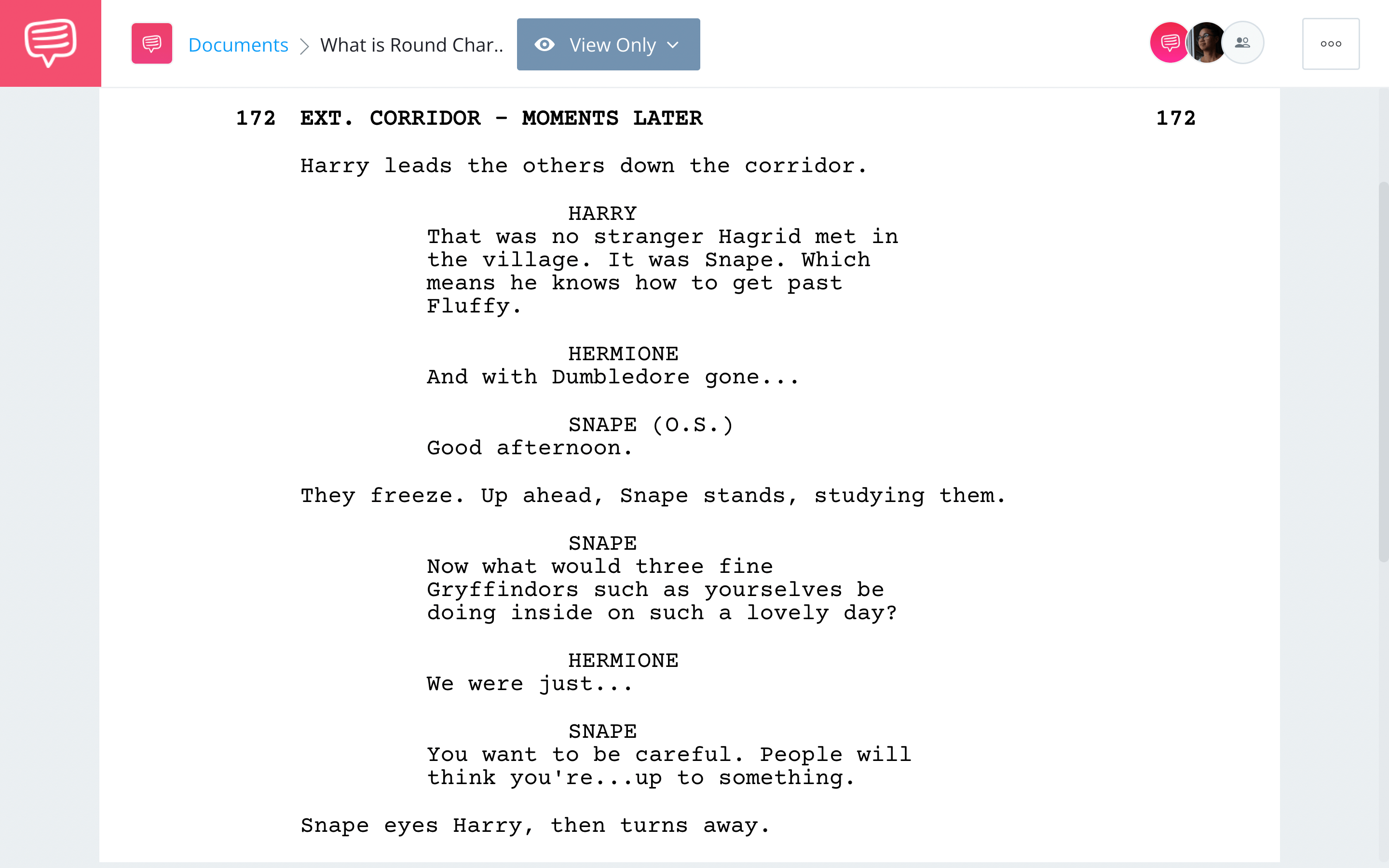Can you tell a good story without a round character? What does it mean to be a round character? There is a good chance most of your favorite movies and shows revolve around the unfolding of these characters. Conversely, stories without any well-developed characters tend to feel unrelatable. They don’t give the audience enough incentive to get invested in the story. In this post we will define what is a round character, and what is not, and show you some examples in film and television so that you can write your own compelling characters. These also work as a round character literary definition for those of you double-timing in screenwriting and novels, plays, and other literature.
What is a Round Character?
First, let’s define round character
To guide your story structure and character design, it’s helpful to have a good round character definition. If a character’s choices and actions over the course of a story are sometimes contradictory, and their personality continues to deepen as the story unfolds, there’s probably a round character.
To determine a round vs. flat character, the main criteria are how much depth a character reveals. But don’t mistake “roundness” to mean whether the character changes or not: a round character literary definition simply describes whether the character has depth.
Let’s define round characters broadly. Then we’ll look at their subtypes.
ROUND CHARACTER DEFINITION
What is a round character?
A round character is complex, layered, and multidimensional. As their personality, inner and outer conflicts, and motivations unfold, they advance the plot. These characters are multifaceted and lifelike. A key part of the round character definition is that these characters have the “surprise” factor. Meaning that they have the ability to do something unexpected as opposed to characters who remain consistent throughout.
Characteristics of a Round Character
- Relatable, often contradictory, and their personality develops over the course of the story
- The Bride in Kill Bill, Shakespeare’s Hamlet, and Celie in The Color Purple are classic examples
For a quick lesson on these two types of characters, let's give our attention to Senior Lecturer Gilad Elbom. He explains how characters like Luke Skywalker and Darth Vader may "seem" round but are actually flat characters.
The Difference Between Round and Flat Characters
Character Examples
Static round characters
What is a round character in literature and what is a dynamic character? Is there a difference? Often, the terms “round” and “dynamic” are used interchangeably when it comes to describing these characters.
While they can overlap, there is an important difference. This is another element we need to add to our definition, the difference between dynamic characters and static characters.
"Round” encompasses both characters who change and those who stay the same. Both types can have "round" characteristics. So you don’t want to confuse round with dynamic.
Harry Potter is also a classic static round character (more on character types from Harry Potter below). Harry undergoes a great journey, but his basic nature never changes. He starts out good, and ends good. We always trust him, and he is always reliable.
Harry Potter • Round and Static
Round characters are always interesting and develop to some degree over the course of the story, in that we continue to get to know them better. But they do not necessarily have to change over the course of the story. Whereas, a dynamic character is always transformed by the story’s end.
A dynamic character is always round (or eventually becomes round, through a transformational journey of some kind most likely).
But these characters does not necessarily have to be dynamic — they can remain static and still be interesting.
Static characters can be compelling protagonists specifically for their inability to change, which is often their downfall.
Think of Fern in Nomadland, who is an excellent example. Her backstory continues to be revealed in bits and pieces throughout the film. We are dropped into Fern’s story while she’s on the road, an itinerant Amazon worker.
Since her choice to live on the road seems to have been instigated by the Great Recession, that might make us think she’s a dynamic character.
Nomadland Trailer • A Character in Rediscovery
But the “twist” at the end of the film comes when we find out she’s always been a nomad, long before she lost her husband and came on hard times. Traveling is just who she is, and she hasn’t really changed at all.
So when you’re designing your characters, it’s good to remember that sometimes the most compelling, confusing, and engaging can be both static and round.
True, static characters are a bit less common. When you’re thinking about what is a round character, it is often round dynamic characters that come to mind. But here are some more examples of characters that are both round and static.
If round characters can be static, what is the difference between round and flat characters? While unyielding and unchanging, static round characters do have depth. And, again, depth is the cornerstone of round characters.
A ROUND CHARACTER EXAMPLE YOU LOVE
Dynamic round characters
When we think, “What is a round character?” we're probably thinking of dynamic characters. All dynamic characters are round by their very nature, because they have depth and complexity that propels them along their journey, which ultimately becomes one of transformation.
For example, Walter White in Breaking Bad is both a round and dynamic character. He exhibits complex dimensions to his personality and he changes significantly over the course of the series. If he only revealed depth and relatability, but no transformation, he would simply be a round character.
But instead, he undergoes a drastic transformation from a suburban dad driving a rundown sedan in the first season, to (spoiler ahead) a notorious drug dealer lying on the floor of a meth lab bleeding out from gunshot wounds in the final episode.
In the following clip from the “I Did it for Me” scene, White’s conversation with his shaken wife marks an important turning point in his descent from good guy dipping into bad guy behaviors to full on criminal:
“I Did it For Me” from Breaking Bad
But all the way through the various stages of White’s dynamic development, he is also a round character, full of complexities and relatability. Even at the end of the very first episode, we have been introduced to his basic conflicts and motivations, an inner crisis that will continue to deepen as the story unfolds.
His wife, Skyler, could arguably be considered static and round. Though she is given room to have dimensionality and contradictions, and colludes with Walter’s criminality to a point (and is thus somewhat dynamic). There is a line drawn, and her basic nature doesn’t fully transform — she never fully “breaks bad.” Her journey in fact helps elucidate the intensity of Walt’s transformation by acting as a foil character to him and helping underscore the fact that he is the main character.
Another popular story that offers good examples of the difference between static and dynamic characters can be found in the Harry Potter series. Specifically, between Harry and Professor Snape. Harry’s essential nature continually deepens but does not change over the course of the series, as befitting of a static character.
He starts out good and ends good, though of course a bit wiser and more experienced after the ordeal of his Hero’s Journey. In our post, What Is a Character Arc, you can get some ideas on how to develop different types of character journeys in your own stories.
Whereas Professor Snape is not only round, but also dynamic. He initially appears to be a stereotypically villainous flat character. But then he surprises us by revealing more sides to his personality: tenderness, love, envy, disappointment, rejection.
Not only does this dimensionality deepen his character, it helps move the story along. These are all the relatable, telltale signs of a round character.
In the following scene from Harry Potter and the Sorcerer’s Stone, Harry, Ron, and Hermione are beginning to get a glimpse of Snape’s many dimensions. We imported the screenplay using StudioBinder's screenwriting software and click the image so you can read the scene below. You can also more scripts like this in our free script library.
What is a Round Character • Read Round Character Example in Harry Potter
What makes Snape also dynamic is that his snakelike persona from the house of Severin shape-shifts from bad guy to good guy so many times we are on the edge of our seats as to whether we can trust him or not. To some extent, the element of surprise is characteristic of any round character.
Snape's character not only deepens and becomes more complex, we see him transform from bad to good and back again. With his dying last words to Harry, his character’s arc concludes in quite a different light than it began.
He is neither good nor bad, fully trustworthy or totally villainous. He has become, in other words, a human being, and his transformations – his inability to maintain goodness or stay evil – has helped foil Harry’s essential goodness, over the course of many trials with the Dark Lord.
In the clip below from Harry Potter and the Half-Blood Prince, we are shocked to see Snape revealing his affiliation to the Dark Lord, while the dialogue between Harry and Snape helps foil each characters’ development.
Harry’s line “We trusted you!” both deepens our understanding of Harry’s essential goodness and sharpens our focus on how Snape has yet again switched allegiances to the bad side:
From Harry Potter and the Half-Blood Prince
These are only a few examples of how round and dynamic characters can add depth and interest to a story, and compelling points of plot development.
Up Next
Dig deeper into flat characters
Another way to understand the role of round characters in the development of a narrative arc is to contrast them to flat characters. While round characters may seem to have all the fun, flat characters play a significant role in plot development and can add dimension and interest to a story in a variety of ways. Check out our post on Flat Characters to get a sense of how they differ.

